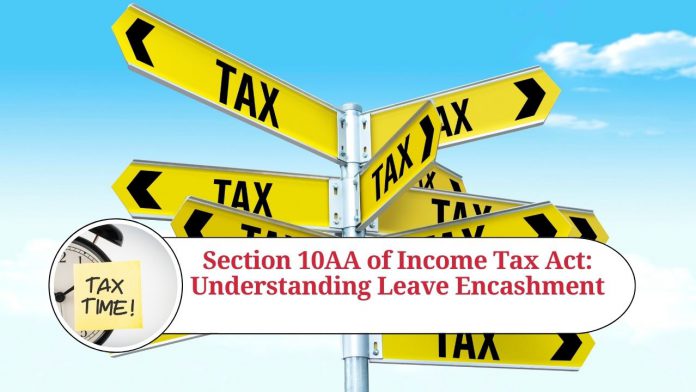Leave encashment is a form of employee benefit that allows an employee to receive payment in exchange for unused leaves. It is a popular practice among employers to offer their employees an opportunity to encash their accrued leaves, especially in cases where the employee has not taken the leaves or has a significant balance of leaves remaining.
The Income Tax Act, 1961, has provisions for the taxation of leave encashment payments. Section 10AA of the Act provides for the taxability of leave encashment payments in various scenarios. In this blog, we will discuss the provisions of Section 10AA in detail.
Applicability of Section 10AA
Section 10AA of the Income Tax Act applies to all leave encashment payments made to an employee during their service period or at the time of retirement, resignation, or termination. It also applies to encashment of leave on superannuation or death.
Taxation of Leave Encashment Payments
The taxability of leave encashment payments depends on the employee’s category, i.e., government employee or non-government employee.
For Government employees, leave encashment payments are fully exempt from tax, regardless of the amount. However, for non-government employees, the exemption is limited to the minimum of the following three amounts:
- Actual leave encashment received
- The cash equivalent of leave balance, i.e., salary that would have been received if the employee had taken the leave instead of encashing it
- Maximum limit specified by the government, which is Rs. 3,00,000 for leave encashment at the time of retirement, resignation, or termination, and 10 months’ average salary for leave encashment on superannuation or death.
It is important to note that the above exemption limit applies to the entire service period and not for each financial year. Therefore, if an employee receives a leave encashment payment of Rs. 2,00,000 in one financial year and Rs. 2,50,000 in another financial year, the exemption limit will be exceeded, and the excess amount will be taxable in the respective years.
Calculation of Average Salary
For the purpose of calculating the maximum limit of leave encashment on superannuation or death, the average salary of the preceding ten months is considered. The average salary includes basic salary, dearness allowance, and commission, if any, but excludes any other allowances, bonuses, or perquisites.
Conclusion
Leave encashment is a common practice among employers, and it is essential to understand the tax implications of such payments. Section 10AA of the Income Tax Act provides clarity on the taxability of leave encashment payments, and it is crucial to comply with the provisions of the Act to avoid any tax-related issues. If you are an employee or an employer, it is advisable to seek professional advice to ensure compliance with the Income Tax Act.
Read more useful content:
- section 234e of income tax act
- section 286 of income tax act
- section 90a of income tax act
- section 40a(7) of income tax act
- section 226(3) of income tax act
- section 24 of income tax act
Frequently Asked Questions (FAQs)
Q. What is Leave Encashment?
A. Leave encashment is a benefit provided to employees by their employers, where they can opt to receive payment in exchange for the unused leaves that they have accumulated.
Q. Does Section 10AA of the Income Tax Act apply to all leave encashment payments?
A. Yes, Section 10AA applies to all leave encashment payments made to an employee during their service period or at the time of retirement, resignation, or termination. It also applies to encashment of leave on superannuation or death.
Q. Are leave encashment payments taxable?
A. The taxability of leave encashment payments depends on the employee’s category, i.e., government employee or non-government employee.
For government employees, leave encashment payments are fully exempt from tax, regardless of the amount. However, for non-government employees, the exemption is limited to the minimum of the following three amounts:
Actual leave encashment received
The cash equivalent of leave balance, i.e., salary that would have been received if the employee had taken the leave instead of encashing it
Maximum limit specified by the government, which is Rs. 3,00,000 for leave encashment at the time of retirement, resignation, or termination, and 10 months’ average salary for leave encashment on superannuation or death.
Q. What is the maximum limit for leave encashment on superannuation or death?
A. The maximum limit for leave encashment on superannuation or death is 10 months’ average salary, as defined by Section 10AA of the Income Tax Act.
Q. How is the average salary calculated for the purpose of leave encashment on superannuation or death?
A. The average salary for the preceding ten months is considered for the purpose of calculating the maximum limit for leave encashment on superannuation or death. The average salary includes basic salary, dearness allowance, and commission, if any, but excludes any other allowances, bonuses, or perquisites.
Q. Is the exemption limit of leave encashment applicable for each financial year or the entire service period?
A. The exemption limit of leave encashment is applicable for the entire service period and not for each financial year. Therefore, if an employee receives a leave encashment payment of Rs. 2,00,000 in one financial year and Rs. 2,50,000 in another financial year, the exemption limit will be exceeded, and the excess amount will be taxable in the respective years.
Q. Is it necessary to seek professional advice for compliance with the provisions of Section 10AA of the Income Tax Act?
A. Yes, it is advisable to seek professional advice for compliance with the provisions of Section 10AA of the Income Tax Act to avoid any tax-related issues.




















